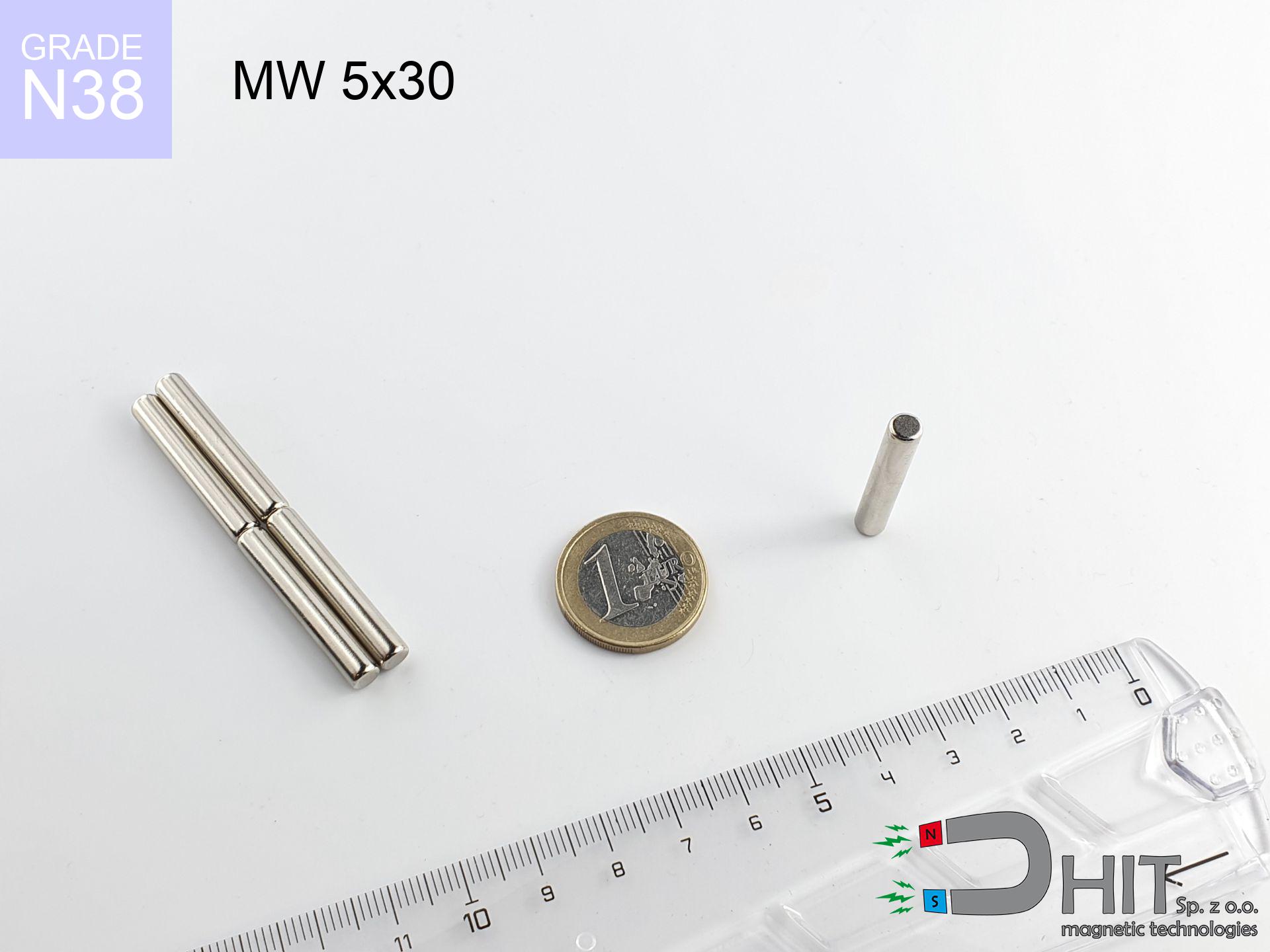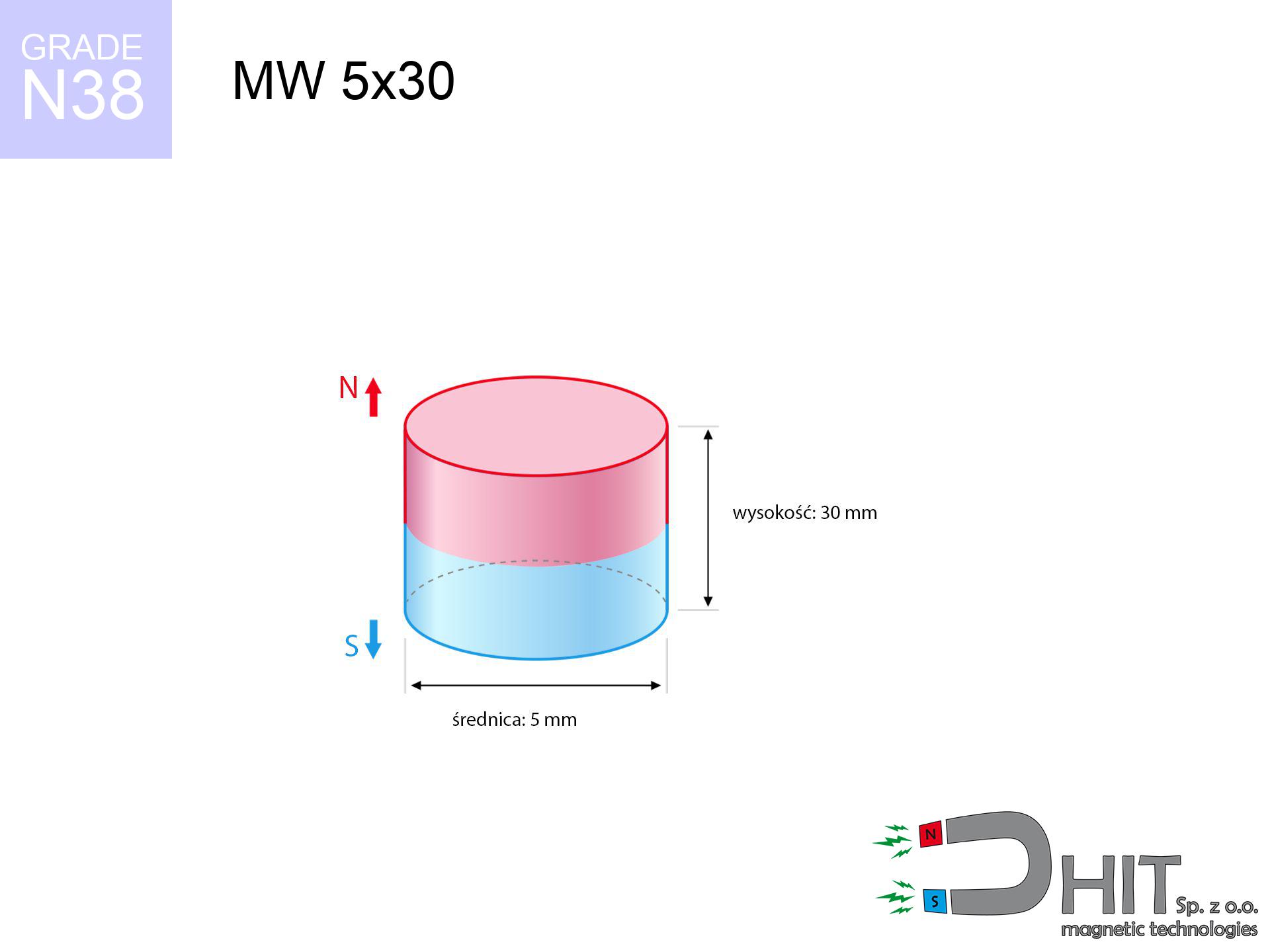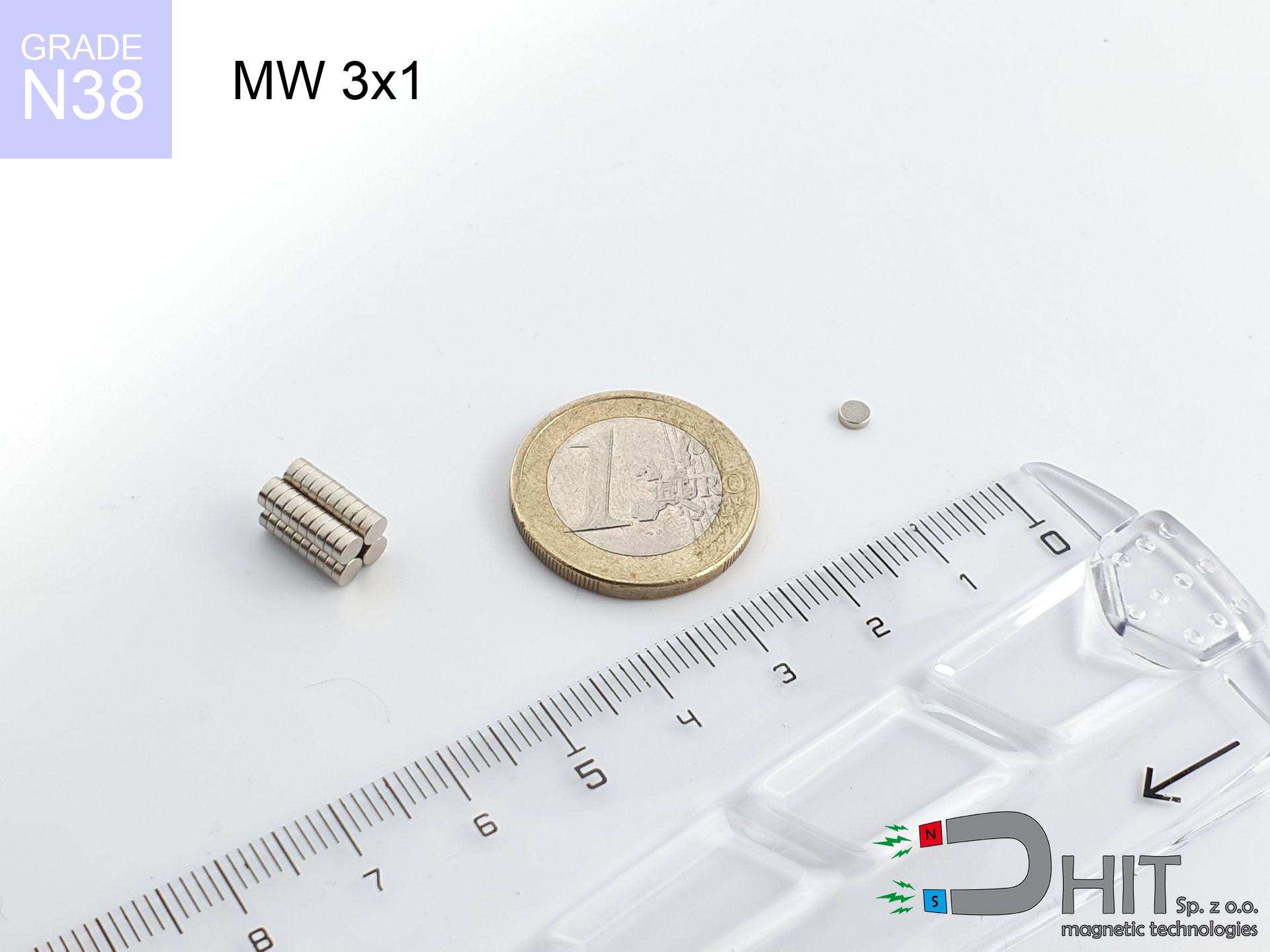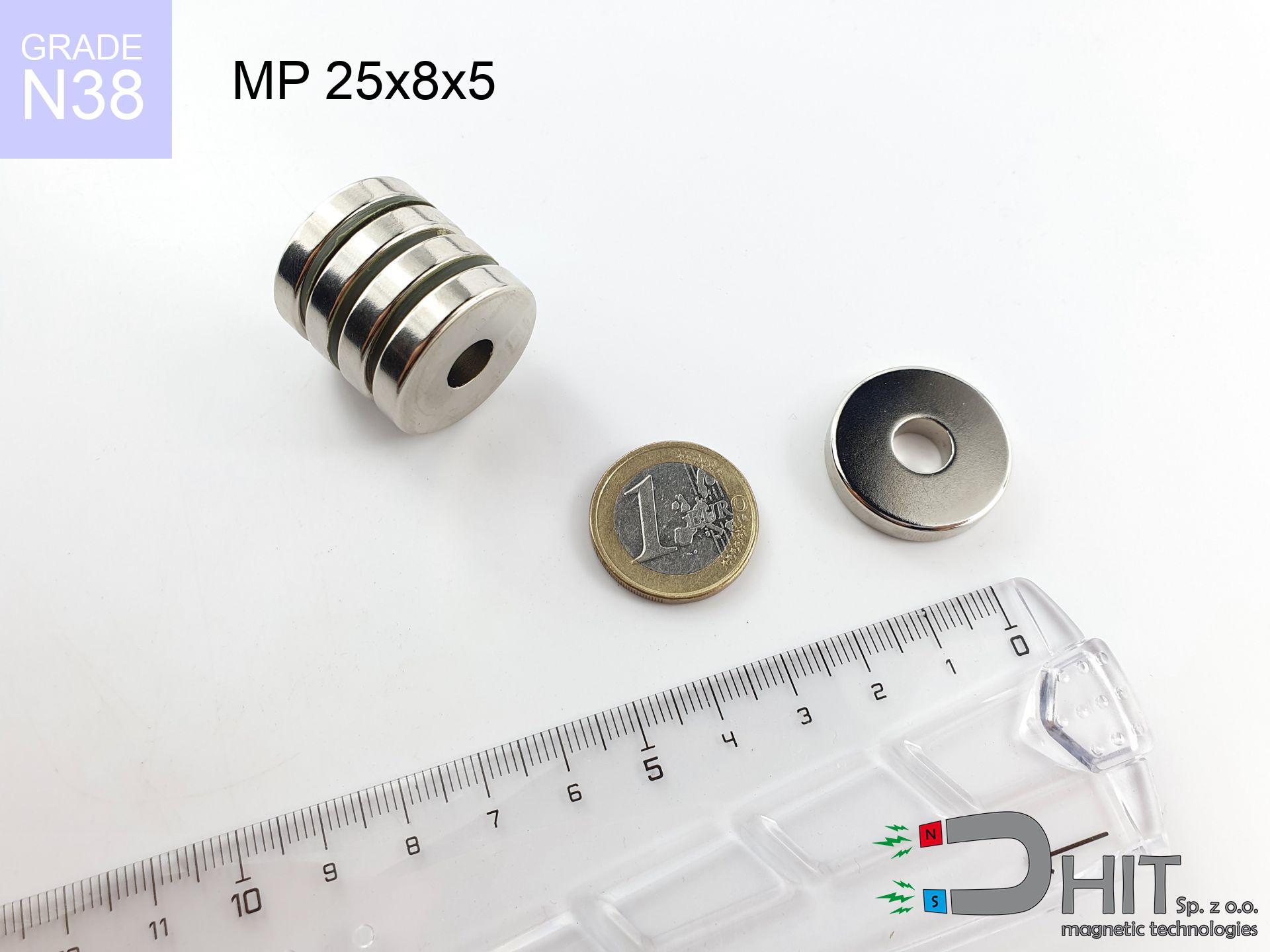MW 5x30 / N38 - cylindrical magnet
cylindrical magnet
Catalog no 010088
GTIN/EAN: 5906301810872
Diameter Ø
5 mm [±0,1 mm]
Height
30 mm [±0,1 mm]
Weight
4.42 g
Magnetization Direction
↑ axial
Load capacity
0.45 kg / 4.40 N
Magnetic Induction
616.32 mT / 6163 Gs
Coating
[NiCuNi] Nickel
3.57 ZŁ with VAT / pcs + price for transport
2.90 ZŁ net + 23% VAT / pcs
bulk discounts:
Need more?
Pick up the phone and ask
+48 22 499 98 98
otherwise let us know using
form
our website.
Specifications as well as structure of magnetic components can be verified with our
magnetic calculator.
Same-day processing for orders placed before 14:00.
Technical - MW 5x30 / N38 - cylindrical magnet
Specification / characteristics - MW 5x30 / N38 - cylindrical magnet
| properties | values |
|---|---|
| Cat. no. | 010088 |
| GTIN/EAN | 5906301810872 |
| Production/Distribution | Dhit sp. z o.o. |
| Country of origin | Poland / China / Germany |
| Customs code | 85059029 |
| Diameter Ø | 5 mm [±0,1 mm] |
| Height | 30 mm [±0,1 mm] |
| Weight | 4.42 g |
| Magnetization Direction | ↑ axial |
| Load capacity ~ ? | 0.45 kg / 4.40 N |
| Magnetic Induction ~ ? | 616.32 mT / 6163 Gs |
| Coating | [NiCuNi] Nickel |
| Manufacturing Tolerance | ±0.1 mm |
Magnetic properties of material N38
| properties | values | units |
|---|---|---|
| remenance Br [min. - max.] ? | 12.2-12.6 | kGs |
| remenance Br [min. - max.] ? | 1220-1260 | mT |
| coercivity bHc ? | 10.8-11.5 | kOe |
| coercivity bHc ? | 860-915 | kA/m |
| actual internal force iHc | ≥ 12 | kOe |
| actual internal force iHc | ≥ 955 | kA/m |
| energy density [min. - max.] ? | 36-38 | BH max MGOe |
| energy density [min. - max.] ? | 287-303 | BH max KJ/m |
| max. temperature ? | ≤ 80 | °C |
Physical properties of sintered neodymium magnets Nd2Fe14B at 20°C
| properties | values | units |
|---|---|---|
| Vickers hardness | ≥550 | Hv |
| Density | ≥7.4 | g/cm3 |
| Curie Temperature TC | 312 - 380 | °C |
| Curie Temperature TF | 593 - 716 | °F |
| Specific resistance | 150 | μΩ⋅cm |
| Bending strength | 250 | MPa |
| Compressive strength | 1000~1100 | MPa |
| Thermal expansion parallel (∥) to orientation (M) | (3-4) x 10-6 | °C-1 |
| Thermal expansion perpendicular (⊥) to orientation (M) | -(1-3) x 10-6 | °C-1 |
| Young's modulus | 1.7 x 104 | kg/mm² |
Physical simulation of the magnet - report
The following information are the direct effect of a physical analysis. Values were calculated on algorithms for the material Nd2Fe14B. Real-world performance may deviate from the simulation results. Treat these data as a preliminary roadmap when designing systems.
Table 1: Static force (pull vs distance) - power drop
MW 5x30 / N38
| Distance (mm) | Induction (Gauss) / mT | Pull Force (kg) | Risk Status |
|---|---|---|---|
| 0 mm |
6154 Gs
615.4 mT
|
0.45 kg / 450.0 g
4.4 N
|
safe |
| 1 mm |
3877 Gs
387.7 mT
|
0.18 kg / 178.6 g
1.8 N
|
safe |
| 2 mm |
2308 Gs
230.8 mT
|
0.06 kg / 63.3 g
0.6 N
|
safe |
| 3 mm |
1419 Gs
141.9 mT
|
0.02 kg / 23.9 g
0.2 N
|
safe |
| 5 mm |
639 Gs
63.9 mT
|
0.00 kg / 4.8 g
0.0 N
|
safe |
| 10 mm |
173 Gs
17.3 mT
|
0.00 kg / 0.4 g
0.0 N
|
safe |
| 15 mm |
75 Gs
7.5 mT
|
0.00 kg / 0.1 g
0.0 N
|
safe |
| 20 mm |
40 Gs
4.0 mT
|
0.00 kg / 0.0 g
0.0 N
|
safe |
| 30 mm |
16 Gs
1.6 mT
|
0.00 kg / 0.0 g
0.0 N
|
safe |
| 50 mm |
5 Gs
0.5 mT
|
0.00 kg / 0.0 g
0.0 N
|
safe |
Table 2: Vertical hold (wall)
MW 5x30 / N38
| Distance (mm) | Friction coefficient | Pull Force (kg) |
|---|---|---|
| 0 mm | Stal (~0.2) |
0.09 kg / 90.0 g
0.9 N
|
| 1 mm | Stal (~0.2) |
0.04 kg / 36.0 g
0.4 N
|
| 2 mm | Stal (~0.2) |
0.01 kg / 12.0 g
0.1 N
|
| 3 mm | Stal (~0.2) |
0.00 kg / 4.0 g
0.0 N
|
| 5 mm | Stal (~0.2) |
0.00 kg / 0.0 g
0.0 N
|
| 10 mm | Stal (~0.2) |
0.00 kg / 0.0 g
0.0 N
|
| 15 mm | Stal (~0.2) |
0.00 kg / 0.0 g
0.0 N
|
| 20 mm | Stal (~0.2) |
0.00 kg / 0.0 g
0.0 N
|
| 30 mm | Stal (~0.2) |
0.00 kg / 0.0 g
0.0 N
|
| 50 mm | Stal (~0.2) |
0.00 kg / 0.0 g
0.0 N
|
Table 3: Vertical assembly (sliding) - behavior on slippery surfaces
MW 5x30 / N38
| Surface type | Friction coefficient / % Mocy | Max load (kg) |
|---|---|---|
| Raw steel |
µ = 0.3
30% Nominalnej Siły
|
0.14 kg / 135.0 g
1.3 N
|
| Painted steel (standard) |
µ = 0.2
20% Nominalnej Siły
|
0.09 kg / 90.0 g
0.9 N
|
| Oily/slippery steel |
µ = 0.1
10% Nominalnej Siły
|
0.05 kg / 45.0 g
0.4 N
|
| Magnet with anti-slip rubber |
µ = 0.5
50% Nominalnej Siły
|
0.23 kg / 225.0 g
2.2 N
|
Table 4: Steel thickness (substrate influence) - sheet metal selection
MW 5x30 / N38
| Steel thickness (mm) | % power | Real pull force (kg) |
|---|---|---|
| 0.5 mm |
|
0.05 kg / 45.0 g
0.4 N
|
| 1 mm |
|
0.11 kg / 112.5 g
1.1 N
|
| 2 mm |
|
0.23 kg / 225.0 g
2.2 N
|
| 5 mm |
|
0.45 kg / 450.0 g
4.4 N
|
| 10 mm |
|
0.45 kg / 450.0 g
4.4 N
|
Table 5: Thermal resistance (stability) - power drop
MW 5x30 / N38
| Ambient temp. (°C) | Power loss | Remaining pull | Status |
|---|---|---|---|
| 20 °C | 0.0% |
0.45 kg / 450.0 g
4.4 N
|
OK |
| 40 °C | -2.2% |
0.44 kg / 440.1 g
4.3 N
|
OK |
| 60 °C | -4.4% |
0.43 kg / 430.2 g
4.2 N
|
OK |
| 80 °C | -6.6% |
0.42 kg / 420.3 g
4.1 N
|
|
| 100 °C | -28.8% |
0.32 kg / 320.4 g
3.1 N
|
Table 6: Two magnets (attraction) - forces in the system
MW 5x30 / N38
| Gap (mm) | Attraction (kg) (N-S) | Repulsion (kg) (N-N) |
|---|---|---|
| 0 mm |
4.58 kg / 4584 g
45.0 N
6 170 Gs
|
N/A |
| 1 mm |
2.98 kg / 2982 g
29.3 N
9 927 Gs
|
2.68 kg / 2684 g
26.3 N
~0 Gs
|
| 2 mm |
1.82 kg / 1820 g
17.9 N
7 755 Gs
|
1.64 kg / 1638 g
16.1 N
~0 Gs
|
| 3 mm |
1.08 kg / 1083 g
10.6 N
5 981 Gs
|
0.97 kg / 974 g
9.6 N
~0 Gs
|
| 5 mm |
0.39 kg / 391 g
3.8 N
3 595 Gs
|
0.35 kg / 352 g
3.5 N
~0 Gs
|
| 10 mm |
0.05 kg / 49 g
0.5 N
1 278 Gs
|
0.04 kg / 44 g
0.4 N
~0 Gs
|
| 20 mm |
0.00 kg / 4 g
0.0 N
346 Gs
|
0.00 kg / 0 g
0.0 N
~0 Gs
|
| 50 mm |
0.00 kg / 0 g
0.0 N
49 Gs
|
0.00 kg / 0 g
0.0 N
~0 Gs
|
Table 7: Safety (HSE) (implants) - precautionary measures
MW 5x30 / N38
| Object / Device | Limit (Gauss) / mT | Safe distance |
|---|---|---|
| Pacemaker | 5 Gs (0.5 mT) | 5.0 cm |
| Hearing aid | 10 Gs (1.0 mT) | 4.0 cm |
| Mechanical watch | 20 Gs (2.0 mT) | 3.0 cm |
| Phone / Smartphone | 40 Gs (4.0 mT) | 2.5 cm |
| Car key | 50 Gs (5.0 mT) | 2.0 cm |
| Payment card | 400 Gs (40.0 mT) | 1.0 cm |
| HDD hard drive | 600 Gs (60.0 mT) | 1.0 cm |
Table 8: Dynamics (cracking risk) - collision effects
MW 5x30 / N38
| Start from (mm) | Speed (km/h) | Energy (J) | Predicted outcome |
|---|---|---|---|
| 10 mm |
10.18 km/h
(2.83 m/s)
|
0.02 J | |
| 30 mm |
17.63 km/h
(4.90 m/s)
|
0.05 J | |
| 50 mm |
22.75 km/h
(6.32 m/s)
|
0.09 J | |
| 100 mm |
32.18 km/h
(8.94 m/s)
|
0.18 J |
Table 9: Surface protection spec
MW 5x30 / N38
| Technical parameter | Value / Description |
|---|---|
| Coating type | [NiCuNi] Nickel |
| Layer structure | Nickel - Copper - Nickel |
| Layer thickness | 10-20 µm |
| Salt spray test (SST) ? | 24 h |
| Recommended environment | Indoors only (dry) |
Table 10: Electrical data (Flux)
MW 5x30 / N38
| Parameter | Value | SI Unit / Description |
|---|---|---|
| Magnetic Flux | 1 468 Mx | 14.7 µWb |
| Pc Coefficient | 1.59 | High (Stable) |
Table 11: Underwater work (magnet fishing)
MW 5x30 / N38
| Environment | Effective steel pull | Effect |
|---|---|---|
| Air (land) | 0.45 kg | Standard |
| Water (riverbed) |
0.52 kg
(+0.07 kg Buoyancy gain)
|
+14.5% |
1. Sliding resistance
*Warning: On a vertical wall, the magnet holds only a fraction of its max power.
2. Steel saturation
*Thin metal sheet (e.g. 0.5mm PC case) drastically limits the holding force.
3. Heat tolerance
*For N38 grade, the max working temp is 80°C.
4. Demagnetization curve and operating point (B-H)
chart generated for the permeance coefficient Pc (Permeance Coefficient) = 1.59
The chart above illustrates the magnetic characteristics of the material within the second quadrant of the hysteresis loop. The solid red line represents the demagnetization curve (material potential), while the dashed blue line is the load line based on the magnet's geometry. The Pc (Permeance Coefficient), also known as the load line slope, is a dimensionless value that describes the relationship between the magnet's shape and its magnetic stability. The intersection of these two lines (the black dot) is the operating point — it determines the actual magnetic flux density generated by the magnet in this specific configuration. A higher Pc value means the magnet is more 'slender' (tall relative to its area), resulting in a higher operating point and better resistance to irreversible demagnetization caused by external fields or temperature. A value of 0.42 is relatively low (typical for flat magnets), meaning the operating point is closer to the 'knee' of the curve — caution is advised when operating at temperatures near the maximum limit to avoid strength loss.
Elemental analysis
| iron (Fe) | 64% – 68% |
| neodymium (Nd) | 29% – 32% |
| boron (B) | 1.1% – 1.2% |
| dysprosium (Dy) | 0.5% – 2.0% |
| coating (Ni-Cu-Ni) | < 0.05% |
Sustainability
| recyclability (EoL) | 100% |
| recycled raw materials | ~10% (pre-cons) |
| carbon footprint | low / zredukowany |
| waste code (EWC) | 16 02 16 |
See also products
Strengths as well as weaknesses of Nd2Fe14B magnets.
Advantages
- They have constant strength, and over nearly 10 years their attraction force decreases symbolically – ~1% (in testing),
- They retain their magnetic properties even under strong external field,
- A magnet with a smooth gold surface is more attractive,
- The surface of neodymium magnets generates a maximum magnetic field – this is one of their assets,
- Due to their durability and thermal resistance, neodymium magnets can operate (depending on the shape) even at high temperatures reaching 230°C or more...
- Due to the possibility of flexible forming and adaptation to custom projects, neodymium magnets can be created in a variety of geometric configurations, which makes them more universal,
- Fundamental importance in electronics industry – they are utilized in HDD drives, electric drive systems, medical devices, also industrial machines.
- Thanks to concentrated force, small magnets offer high operating force, in miniature format,
Cons
- To avoid cracks under impact, we recommend using special steel holders. Such a solution protects the magnet and simultaneously increases its durability.
- Neodymium magnets demagnetize when exposed to high temperatures. After reaching 80°C, many of them experience permanent weakening of strength (a factor is the shape and dimensions of the magnet). We offer magnets specially adapted to work at temperatures up to 230°C marked [AH], which are extremely resistant to heat
- When exposed to humidity, magnets usually rust. For applications outside, it is recommended to use protective magnets, such as those in rubber or plastics, which prevent oxidation as well as corrosion.
- We recommend cover - magnetic holder, due to difficulties in realizing threads inside the magnet and complicated forms.
- Possible danger resulting from small fragments of magnets are risky, in case of ingestion, which gains importance in the context of child health protection. Furthermore, small elements of these magnets are able to disrupt the diagnostic process medical after entering the body.
- Higher cost of purchase is one of the disadvantages compared to ceramic magnets, especially in budget applications
Holding force characteristics
Maximum lifting capacity of the magnet – what it depends on?
- on a plate made of structural steel, effectively closing the magnetic flux
- possessing a thickness of minimum 10 mm to ensure full flux closure
- with a plane free of scratches
- without any insulating layer between the magnet and steel
- under vertical application of breakaway force (90-degree angle)
- at temperature room level
Impact of factors on magnetic holding capacity in practice
- Clearance – the presence of any layer (paint, dirt, gap) acts as an insulator, which lowers capacity rapidly (even by 50% at 0.5 mm).
- Loading method – catalog parameter refers to detachment vertically. When attempting to slide, the magnet holds significantly lower power (typically approx. 20-30% of maximum force).
- Plate thickness – too thin plate causes magnetic saturation, causing part of the power to be wasted to the other side.
- Steel type – low-carbon steel gives the best results. Alloy steels decrease magnetic permeability and holding force.
- Plate texture – smooth surfaces ensure maximum contact, which improves field saturation. Rough surfaces weaken the grip.
- Temperature influence – high temperature reduces magnetic field. Exceeding the limit temperature can permanently demagnetize the magnet.
Holding force was measured on the plate surface of 20 mm thickness, when a perpendicular force was applied, however under parallel forces the holding force is lower. In addition, even a minimal clearance between the magnet and the plate lowers the lifting capacity.
Safe handling of neodymium magnets
Do not drill into magnets
Drilling and cutting of neodymium magnets poses a fire hazard. Magnetic powder oxidizes rapidly with oxygen and is difficult to extinguish.
Risk of cracking
Despite metallic appearance, neodymium is delicate and cannot withstand shocks. Avoid impacts, as the magnet may shatter into hazardous fragments.
Pacemakers
Health Alert: Neodymium magnets can deactivate pacemakers and defibrillators. Do not approach if you have electronic implants.
Crushing force
Watch your fingers. Two large magnets will snap together instantly with a force of several hundred kilograms, crushing anything in their path. Be careful!
Swallowing risk
Neodymium magnets are not toys. Accidental ingestion of a few magnets may result in them pinching intestinal walls, which constitutes a direct threat to life and requires urgent medical intervention.
Safe operation
Use magnets with awareness. Their powerful strength can shock even experienced users. Stay alert and respect their force.
Maximum temperature
Monitor thermal conditions. Exposing the magnet to high heat will ruin its magnetic structure and pulling force.
GPS Danger
An intense magnetic field interferes with the functioning of compasses in smartphones and navigation systems. Keep magnets near a device to avoid damaging the sensors.
Sensitization to coating
Some people have a sensitization to nickel, which is the typical protective layer for neodymium magnets. Prolonged contact may cause a rash. We strongly advise use safety gloves.
Safe distance
Powerful magnetic fields can corrupt files on credit cards, hard drives, and other magnetic media. Maintain a gap of at least 10 cm.





![SM 25x275 [2xM8] / N52 - magnetic separator SM 25x275 [2xM8] / N52 - magnetic separator](https://cdn3.dhit.pl/graphics/products/sm-25x275-2xm8-vih.jpg)



